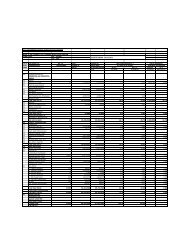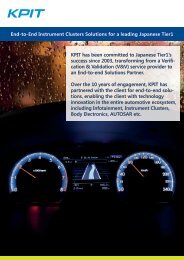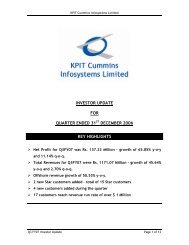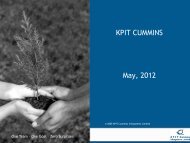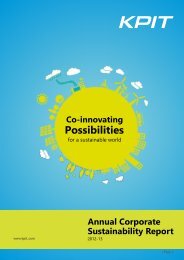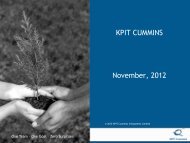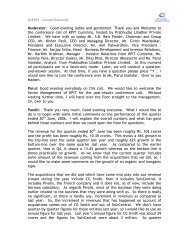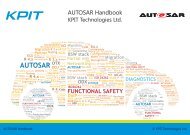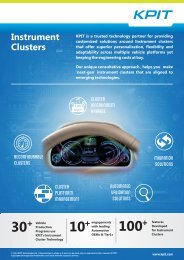Connected world - KPIT Cummins
Connected world - KPIT Cummins
Connected world - KPIT Cummins
You also want an ePaper? Increase the reach of your titles
YUMPU automatically turns print PDFs into web optimized ePapers that Google loves.
Sparta Infotech India Private Limited<br />
Schedule XII - Signifi cant Accounting Policies and Notes to<br />
Accounts<br />
Company Overview<br />
Sparta Infotech India Private Limited was incorporated on 25th August, 2007 under the Companies Act,<br />
1956 and is subsidiary of Sparta Consulting Inc., USA.<br />
Sparta Infotech India Private Limited (herein referred to as “Company”) is in the business of providing<br />
software consulting, system design, enterprise application and computer programming services to<br />
its customers from domestic and offshore location and has its development facility located at Special<br />
Economic Zone, Noida.<br />
1. Signifi cant Accounting Policies<br />
Basis for preparation of fi nancial statements<br />
The fi nancial statements are prepared in accordance with Indian Generally Accepted Accounting<br />
Principles (‘GAAP’) under the historical cost convention on accrual basis. All items of income and<br />
expenditure having a material bearing on the fi nancial statements are recognized on the accrual basis.<br />
GAAP comprises mandatory accounting standards as prescribed by the Companies Accounting<br />
Standard Rules, 2006 and the provisions of Companies Act, 1956.<br />
Use of Estimates<br />
The preparation of fi nancial statements requires the management of the Company to make estimates<br />
and assumptions that affect the reported balances of assets and liabilities and disclosures relating to<br />
the contingent liabilities as at the date of fi nancial statements and reported amounts of income and<br />
expenditure during the year.<br />
1.1. Revenue recognition<br />
The Company derives revenues primarily from software related services. Arrangement with<br />
customers for software related services are either on a fi xed price or on time and material<br />
basis.<br />
Revenue on time and material contracts is recognized as the related services are performed<br />
and revenue from the end of the last billing to the balance sheet date is recognized as unbilled<br />
revenues. Revenue from fi xed-price contracts are recognized as per percentage of completion<br />
method which is determined on the basis of time incurred as a proportion of budgeted time.<br />
Costs and earnings in excess of costs and earnings are classifi ed as unearned revenue on<br />
individual contract basis.<br />
1.2. Expenditure<br />
Expenses are accounted on the accrual basis and provisions are made for all known losses and<br />
liabilities.<br />
1.3. Provision for Doubtful Debts<br />
The Company carries out the periodic exercise to evaluate its receivables.<br />
While making such provision, various other factors like probable recovery of the dues,<br />
business risks, economic factors, legal status of the customer / Joint Ventures / Partners are<br />
taken into account.<br />
1.4. Fixed Assets, Intangible Assets and Capital Work-in-Progress<br />
(a) Fixed Assets are stated at the cost of acquisition, less accumulated depreciation and<br />
impairment loss, if any. Direct costs are capitalized till the assets are put to use.<br />
(b) Intangible Assets<br />
If a Company incurs expenditure which meets criteria of intangible asset as mentioned in<br />
Accounting Standard 26, such expenditure is capitalized and is amortized over its useful<br />
life as estimated by the Management.<br />
1.5. Depreciation<br />
Depreciation on fi xed assets is provided using straight-line method based on useful life of<br />
assets as estimated by the Management. Depreciation is charged on all assets purchased and<br />
sold during the year on a proportionate basis. The rates of depreciation are as per or above<br />
minimum rates prescribed under Schedule XIV of the Companies Act, 1956. The Rates of<br />
Depreciation are as follows:<br />
Individual assets costing less than ` 5,000/- are depreciated at the rate of 100%. Permanent<br />
improvements to the leasehold property are depreciated over the lease term or useful life<br />
whichever is shorter.<br />
• Furniture and fi ttings - 20.00%<br />
• Computer Equipments and Software - 33.33%<br />
• Vehicles - 20.00%<br />
• Offi ce Equipments - 20.00%<br />
• Buildings - Over the lease period of land<br />
1.6. Impairment of Assets<br />
The Management periodically assesses using, external and internal sources, whether there is<br />
an indication that an asset may be impaired. Impairment loss is recognised when the carrying<br />
value of an asset exceeds its recoverable amount. The recoverable amount is higher of the<br />
asset’s net selling price and value in use, which means the present value of future cash fl ows<br />
expected to arise from the continuing use of the asset and its eventual disposal.<br />
1.7. Leases<br />
Assets leased by the Company in the capacity of the Lessee, where the Company has<br />
substantially all the risks and rewards of ownership are classifi ed as Finance Lease. Such<br />
leases are classifi ed at the inception of Lease at lower of the Fair Value or the present value of<br />
minimum lease payments and a liability is created for an equivalent amount. Each lease rental<br />
paid is allocated between the liability and interest cost so as to obtain a constant period rate of<br />
interest on the outstanding liability for each year.<br />
Lease arrangement where the risks and rewards incidental to the ownership of an asset<br />
substantially vest with the lessor, are recognised as Operating Lease. Lease Rentals under<br />
operating lease are recognised in the Profi t and Loss Account on straight line basis.<br />
38<br />
1.8. Foreign currency transactions<br />
Foreign currency denominated monetary assets and liabilities are translated at exchange<br />
rates in effect at the Balance Sheet date. The gains or losses resulting from such transactions<br />
are included in the Profi t and Loss Account. Income and expenses denominated in foreign<br />
currencies are translated using exchange rate in effect on the date of transaction. Transaction<br />
gains or losses realized upon settlement of foreign currency transactions are included in<br />
determining the net profi t for the period in which transaction is settled.<br />
1.9. Retirement benefi ts to employees<br />
Contribution to the provident fund is recognized as an expense in the Profi t and Loss account<br />
in the year in which contribution is due.<br />
Gratuity and leave encashment which are defi ned benefi ts are accrued on an actuarial valuation<br />
carried out by an independent actuary at each balance sheet date.<br />
1.10. Accounting for Taxes on Income<br />
Income tax comprises of current tax (i.e. amount of tax for the period determined in accordance<br />
with the income tax law) and deferred tax (refl ecting the tax effects of timing differences<br />
between accounting income and taxable income for the period). The deferred tax charge or<br />
credit and the corresponding deferred tax liabilities or assets are recognized using the tax rates<br />
that they will be realized in future; however where there is unabsorbed depreciation and carry<br />
forward loss under taxation laws, deferred tax assets are recognized only if there is a virtual<br />
certainty of realization of such assets. Deferred tax assets are reviewed at each balance sheet<br />
date and written down or written up to refl ect the amount that is reasonably/virtually certain<br />
(as the case may be) to be realized.<br />
Timing differences which reverse within the tax holiday period, do not result in tax consequence<br />
and therefore no deferred taxes are recognized in respect of the same. For this purpose, the<br />
timing differences, which originate fi rst, are considered to reverse fi rst.<br />
1.11. Provisions, Contingent Liabilities and Contingent Assets<br />
As per Accounting Standard 29, ‘Provisions, Contingent Liabilities and Contingent Assets’, the<br />
Company recognizes provisions only when it has a present obligation as a result of a past event,<br />
it is probable that an outfl ow of resources embodying economic benefi ts will be required to settle<br />
the obligation and when a reliable estimate of the amount of the obligation can be made.<br />
No Provisions is recognized for –<br />
A. Any possible obligation that arises from past events and the existence of which will be<br />
confi rmed only by the occurrence or non-occurrence of one or more uncertain future<br />
events not wholly within the control of the Company; or<br />
B. Any present obligation that arises from past events but is not recognized because-<br />
1) It is not probable that an outfl ow of resources embodying economic benefi ts will<br />
be required to settle the obligation; or<br />
2) A reliable estimate of the amount of obligation cannot be made.<br />
Such obligations are recorded as Contingent Liabilities. These are assessed<br />
periodically and only that part of the obligation for which an outfl ow of resources<br />
embodying economic benefi ts is probable, is provided for, except in the extremely<br />
rare circumstances where no reliable estimate can be made.<br />
Contingent Assets are not recognized in the fi nancial statements since this may result in the<br />
recognition of income that may never be realized.<br />
1.12. Cash Flow Statement<br />
Cash Flows are reported using the indirect method, whereby net profi ts before tax is adjusted<br />
for the effects of transactions of a non-cash nature and any deferrals or accruals of past or<br />
future cash receipts or payments. The cash fl ows from regular revenue generating, investing<br />
and fi nancing activities of the Company are segregated.<br />
2. Disclosures as required by Schedule VI of the Companies Act, 1956<br />
2.1 Managerial Remuneration:<br />
(` in Lacs)<br />
2011 2010<br />
Salary and allowances 76.80 34.32<br />
Contribution to provident fund 1.54 0.54<br />
Total 78.34 34.86<br />
Information relating to managerial remuneration does not include provision for gratuity<br />
and leave encashment, which is provided on an overall basis. Perquisites are valued by<br />
management at cost/fair values. Computation of net profi ts in accordance with Section 349 of<br />
the Companies Act, 1956 has not been given, as commission by way of percentage of profi ts<br />
for the year is not payable to the key managerial personnel.<br />
2.2 Capital Commitments<br />
(` in Lacs)<br />
2011 2010<br />
Estimated amount of contracts remaining to be<br />
executed on capital account (net of advances) not<br />
provided for 18.86 56.87<br />
2.3 In the opinion of the Board of Directors, Current Assets, Loans and Advances have a value on<br />
realization in ordinary course of business at least equal to the amount at which they are stated<br />
in the Balance sheet.<br />
2.4 Contingent Liabilities not provided for ` Nil. (Previous Year Nil)<br />
2.5 Value of imports on CIF basis:<br />
(` in Lacs)<br />
2011 2010<br />
Capital goods 9.14 Nil




